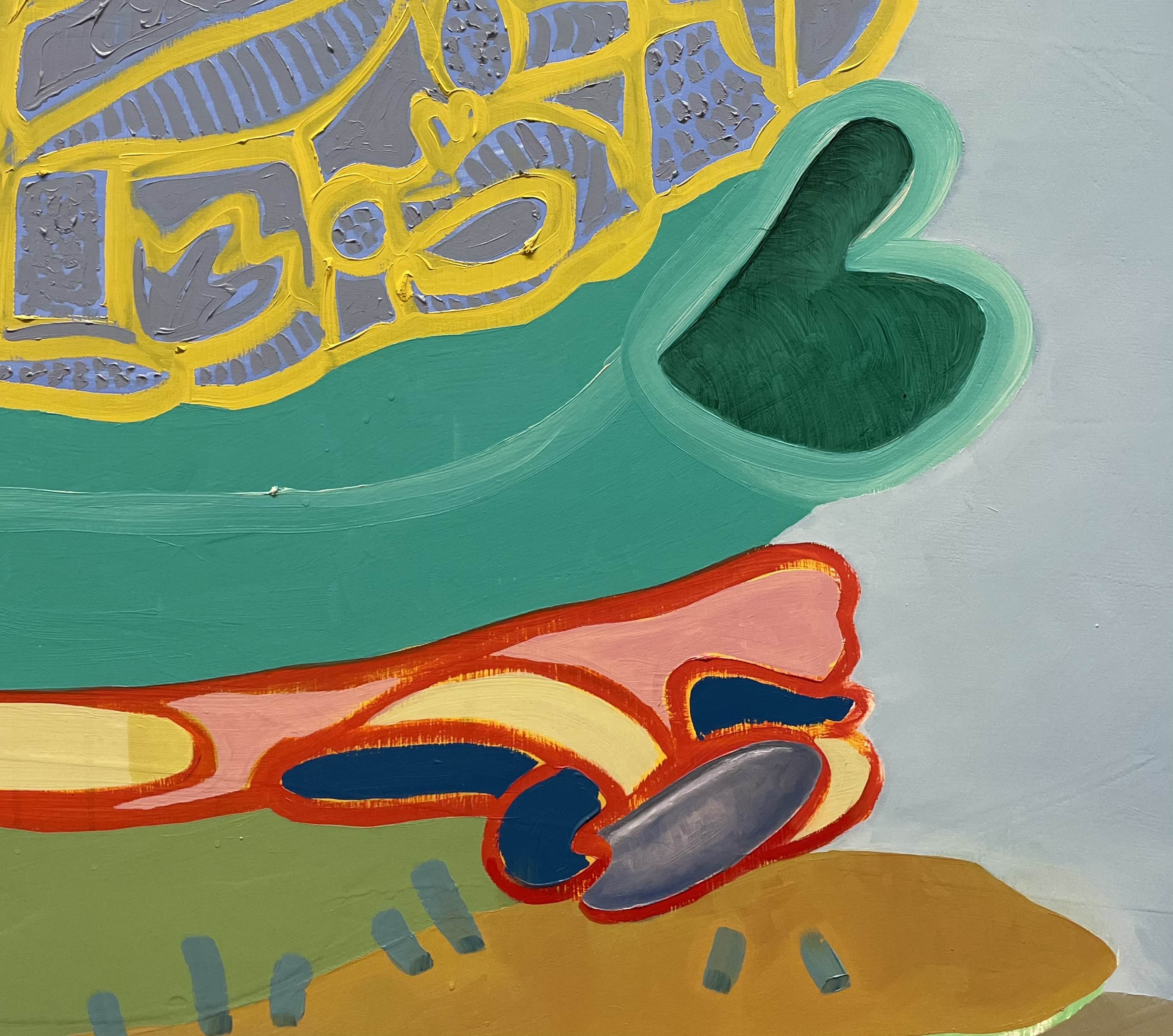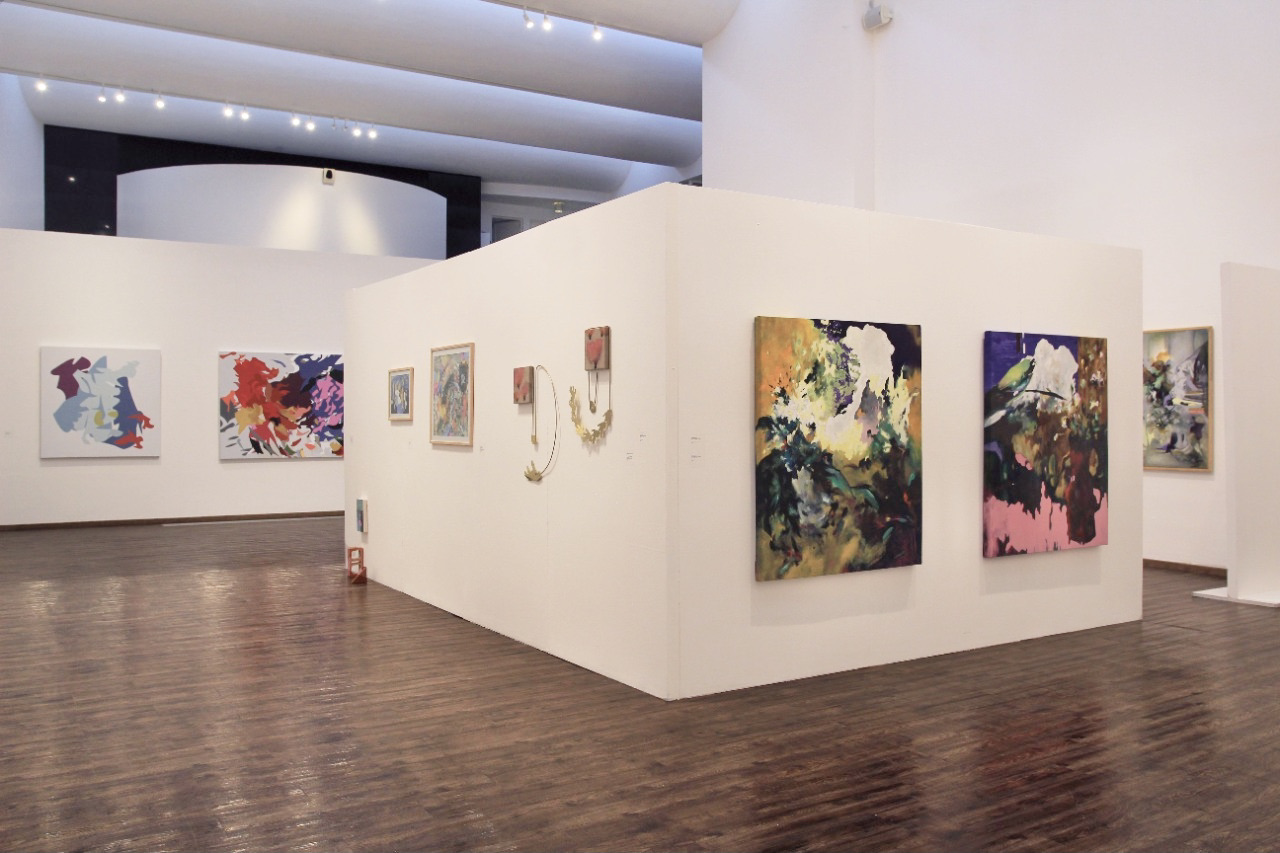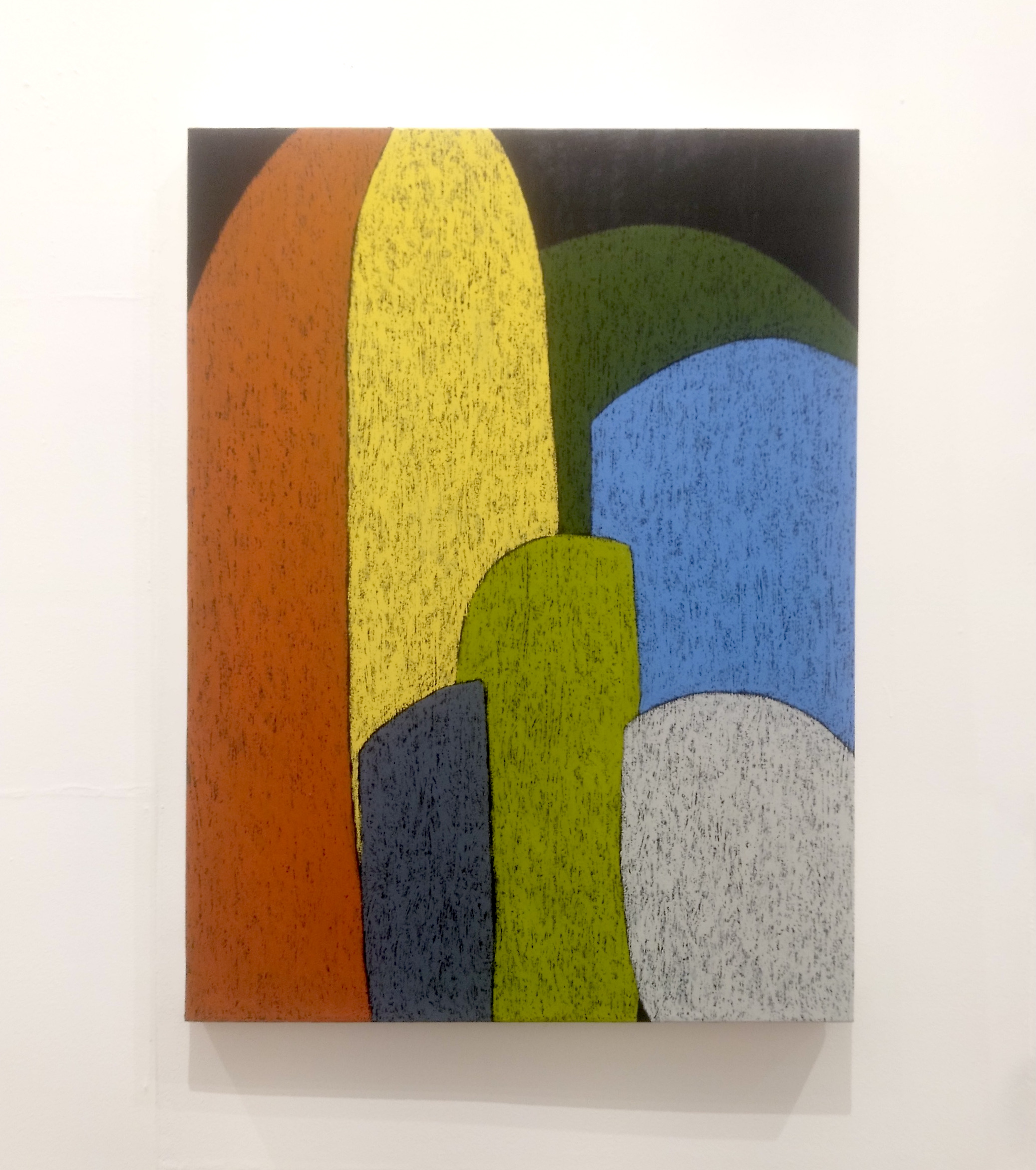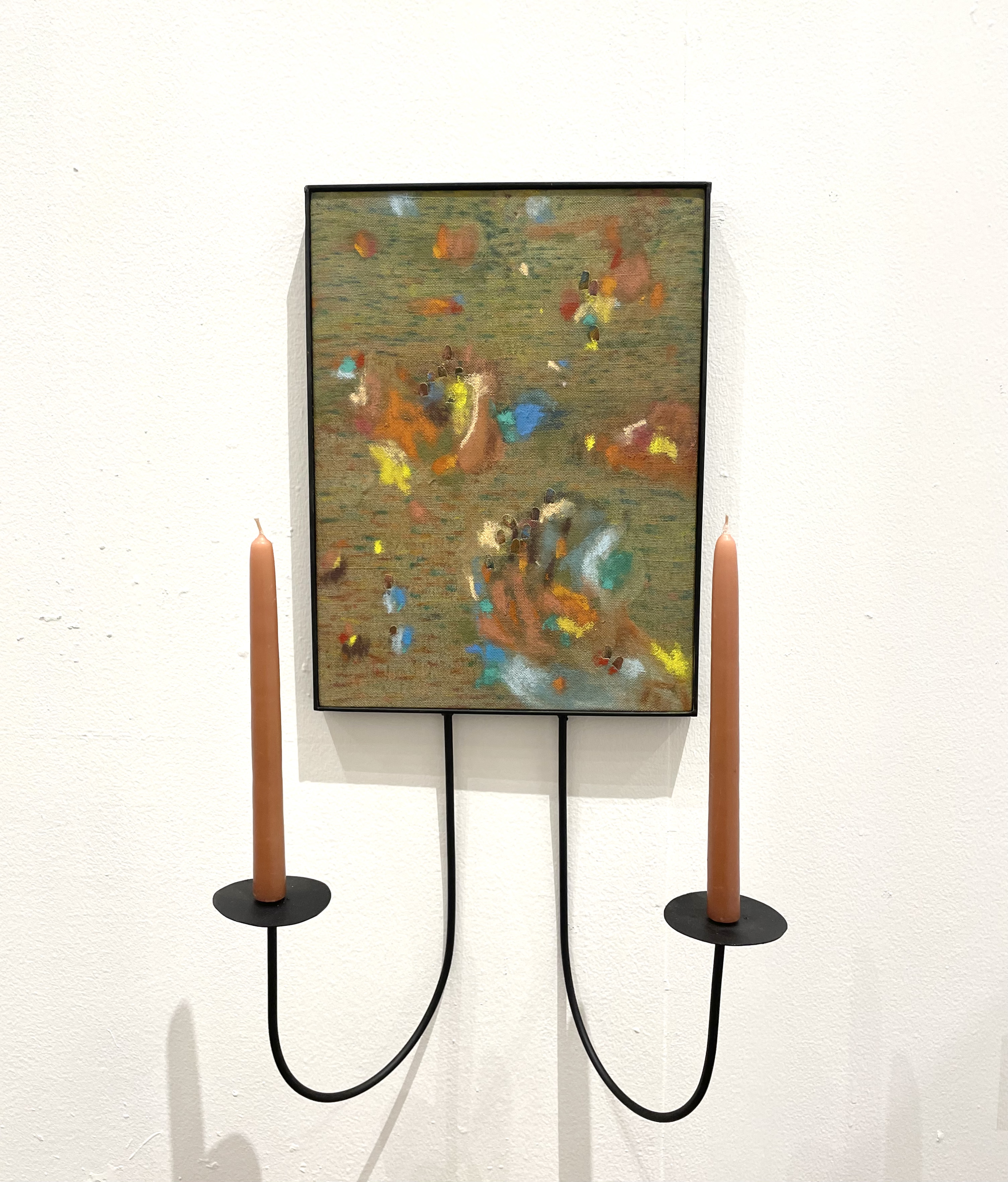
Review
On Amimetics, Cosmetics, and Possible Trances. About 'Un fenómeno imposible de prever'
by Diana Garza Islas
At Centro Cultural Plaza Fátima
Reading time
7 min
In recent years, we have seen an effort to highlight the importance of women in the early days of abstraction. The handover from Kandinsky to Hilma af Kint as pioneer of abstract art is an example of this revisionism, which has in turn sparked an interest in abstract art made by women today. In Un fenómeno imposible de prever [A Phenomenon Impossible to Foresee], curated by Virginie Kastel for Centro Cultural Plaza Fátima, we can find a certain gesture in that direction.
The show features the work of five Mexican women dedicated to abstract painting: Sofía Ortiz, Leonora Serra, Tahanny Lee Betancourt, Alejandra Quintanilla y Othiana Roffiel. I consider some of the pieces exhibited here so innocuous that one could very well find them decorating a living room. Nevertheless, is merely ornamental abstract art a real problem? And in any case, a problem for whom? The act of rewriting the history of abstraction while taking into account women’s contributions since its inception implies that in exhibitions of abstract artists the ornamental is to be considered alongside “true” art. The separation between fine arts and applied arts is a symptom of a dualistic epistemology that does not correspond to the complexity of the real: it has associated women with the concrete, while associating the abstract with a “higher” cognitive capacity. When theorizing about a universal pictorial language, the ex-pioneers of abstractionism reviled certain techniques, supports, and forms related to the feminine polarity, whose aesthetic, albeit abstract, was relegated to the field of decoration.

The root of that word, decorate, is related to cosmetics, and that to cosmos. Decoration, insofar as it implies arranging elements in order to give harmony to a whole, and thus giving order to a cosmos, is itself an epistemic statement. Seen this way, the merely ornamental abstract is a problem for those who prefer a different order, one in which things are just things, and what govern are ideas. Duality and hierarchy continue to prevail.
The theme motivating this exhibition is nature: not an imitated nature, but rather an emitted one. In a kind of parthenogenesis, the shows opens with two pieces by Ortiz, who presents a series of fragmented phytomorphs, seen from all possible angles. Their nature is reassembly: a piece of cloud that was discarded reappears on another canvas, establishing a continuous variable cloudiness.
Following this aesthetic, Serra transports us to lands of snow, pink, and viridian—colors that witches have for breakfast—surrounded by lively still lifes as well as even more lively natures, mutable like the tide. Her title, Modos de hacer un jardín [Ways to Make a Garden], could be applied to all the pieces in the exhibition, since each one constructs a small place in the world out of scraps, reaffirming that the forests live in our (feminine) selves.

Quintanilla has a different way of approaching the fragment. In her paintings, nature seems to have been abolished. Close to geometric abstractionism, her methods contemplate the removal and cutting of fragments that are superimposed on other pieces, like puzzles that invite a decoding, but with nothing to interpret. The reality of color and shape are overwhelming, like nature itself: they are what cannot and need not be said. In this sense, the gesture of not titling her pieces is congruent with her proposal.
Tangential to this line are the works of Roffiel, who performs a semiotic game with her titles, creating semantic alternatives. From a naive, veiled pop streak, which might remind us of eighties textile design, her work results in paradoxical explanations about its possible themes, thus ironizing the act of explanation itself. The statement Esto que es aquello [This That is That] could function as a definition of metaphor, but in the painting bearing that title the metaphor collapses: Can an obviously phallic figure still be a metaphor for something? By highlighting the turgidity of the phalolith, in this era of Freudian metaphorisms, the painting is revealed as a childish and as an intellectual joke at the same time. In Roffiel’s work, an exercise of intuitive rationality operates from a basis in chaos, a movement that organizes contradiction in a conceptual game promoting confusion.

Lee Betancourt expands on this conceptual gesture, relying not on text in order to complement her pieces, but rather on objects. In three of these, we find arms, hands, or something similar, reminding us of what exceeds our body and yet is still our body. Through these extensions, the artist shows how the object can be a member of the subject, constructing hybrid entities in a symbiotic relationship with its residue, proposing an identity between the noun and its complements. Mother by night evidences this problem: from a painting there extends a candelabra, suggesting a period mirror. What image does it return to me? Fragments of myself, I who am something else, blotches from an overpainted brush. This assemblage also suggests something amorphously human: Are those arms that come out of the painting? What do those insistent limbs mean in her pieces? Tempting, not knowing, the artist seems to indicate something to us—in blind and vivid exploration, prior to seeing and to wanting to signify.
All the artists in this exhibition reflect on language in its attempt to yield meaning: from metaphor and semic displacement (Lee Betancourt), winks toward linguistic contradictions and the absurdity of interpretations of statements (Roffiel), passing through the impulse to create natures that are neither living nor dead nor imitative, but rather their own (Serra, Ortiz). We see the possibility of an art without allegorical intermediations, the affirmation of an epistemology of the body and also the commitment to a mathematical language as a structure of meaning, present in geometric distribution on the plane (Quintanilla).

In addition to this problematization of language, a gesture that homologates these artists is the trance as method. In Ortiz’s pieces, this is suggested in the diptych Experimentos con el atasque y Bajón, which allude to the use of psychoactive substances, perhaps to promote altered perceptions as an incentive to creation. From that point, there is a continuity with abstract art in its origins and in its spiritual project, which had considered trance as a way of accessing supernatural experiences, or experiences that exceeded conventional human rationality. I think of the validity of this method and of the formalization of catharsis as cure. Emma Kunz, among other forerunners of the abstract, used her graphic works as aids to healing. To what extent could contemporary abstract art come close to that?
An etymology of cure tells us that it means takes charge. Considered this way, trance as well as amimetic and asemic practices can constitute a healing path, one that encourages an approach to the world that is beyond rationality and meaning, in pursuit of an intuitive and corporeal apprehension. Klee stated that a painter should not paint what they see, but what they will see. Based on this exhibition, and against visionary certainty, I sense that painting is not about what will be seen, nor about the invisible made visible, but rather about signaling that area still beyond the visual that occurs in presence. The trance remains in force as a way of healing ourselves and of healing [curar, curator]—in a cosmetic sense—the objects that surround us.
Translated to English by Byron Davies
Cover picture: detail of a work by Othiana Roffiel
Published on November 16 2021